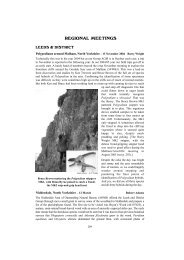Full Contents as pdf File - Natural History Museum
Full Contents as pdf File - Natural History Museum
Full Contents as pdf File - Natural History Museum
You also want an ePaper? Increase the reach of your titles
YUMPU automatically turns print PDFs into web optimized ePapers that Google loves.
LECTURE MEETINGS AND DAY VISITS 2003<br />
SPRING INDOOR MEETING, THE NATURAL HISTORY MUSEUM, LONDON<br />
– 22 March Graham Ackers<br />
As h<strong>as</strong> happened frequently in the p<strong>as</strong>t, this meeting w<strong>as</strong> held at The <strong>Natural</strong> <strong>History</strong><br />
<strong>Museum</strong>, a highly appropriate and conveniently central venue. The <strong>Museum</strong>, and in<br />
particular the Society’s members on the professional staff, have always been most<br />
supportive of our activities, and this event w<strong>as</strong> no exception. The Mineralogy Seminar<br />
Room w<strong>as</strong> a new venue for us and w<strong>as</strong> ideal for this meeting. For the morning session it<br />
w<strong>as</strong> felt appropriate to reflect the work of the <strong>Museum</strong>, and so we were treated to three talks<br />
on the themes of fern cl<strong>as</strong>sification and curation.<br />
The first talk, by Josephine Camus, w<strong>as</strong> titled ‘<strong>History</strong> of fern cl<strong>as</strong>sification’. The pre-<br />
Linnaean fern names situation w<strong>as</strong> illustrated by Josephine showing pictures of some<br />
ancient (16th century) manuscripts. Here we saw how the identities of Asplenium<br />
scolopendrium and A. ceterach were confused; this w<strong>as</strong> important <strong>as</strong> they were used to treat<br />
very different ailments. However, the earlier conquering influence of the Romans had<br />
imposed a de facto Latin language standard for the publication of learned works. Josephine<br />
then established the need for accurate naming, by showing slides of both Hyacinthoides<br />
non-scripta and Campanula rotundifolia, both being known <strong>as</strong> a bluebell in England and<br />
Scotland respectively. Definitions of systematics, taxonomy and phylogeny were presented,<br />
and the species w<strong>as</strong> cited <strong>as</strong> the unit of cl<strong>as</strong>sification. The binomial system of Linnaeus w<strong>as</strong><br />
introduced in the Species Plantarum in 1753 (the b<strong>as</strong>eline for plant names). Perhaps some<br />
members of the audience were unaware of the fact that the establishment of Linnaeus’<br />
binomial system w<strong>as</strong> partly accidental. Linnaeus’ adopted approach w<strong>as</strong> to provide an<br />
extended Latin name for each organism, plus a shortened form (the binomial) for<br />
convenient use where the longer form w<strong>as</strong> inappropriate or unnecessary. The shortened<br />
form prevailed! Although John Ray had thought that all parts of a plant should be used for<br />
cl<strong>as</strong>sification, Linnaeus chose to b<strong>as</strong>e his fern taxonomy on the sorus alone. This approach<br />
continued to be followed by such luminaries <strong>as</strong> W.J. Hooker and J.G. Baker, although<br />
others had started to consider the use of non-soral characters. However, the real<br />
breakthrough did not occur until the 1940s, when R.C. Ching started to use a multiplicity of<br />
characters. He and other authors presented their own systems for the higher cl<strong>as</strong>sification of<br />
ferns, entailing the differentiation of many more genera than Linnaeus had defined. This in<br />
turn h<strong>as</strong> contributed to the convoluted naming history of many ferns, and Josephine<br />
provided detailed examples with two well known ferns – Phlebodium aureum and<br />
Gymnocarpium dryopteris. Despite being e<strong>as</strong>ily recognisable and stable entities, both<br />
species have been encumbered with many names in the p<strong>as</strong>t! The talk included a discussion<br />
of naming processes – the type specimen concept, the meanings of names, abbreviations of<br />
authors, generic changes, and in particular the current importance of the International Code<br />
of Botanical Nomenclature. Josephine’s talk w<strong>as</strong> full of f<strong>as</strong>cinating detail, and this brief<br />
summary does no more than give a flavour of its content.<br />
The next talk w<strong>as</strong> given by Alison Paul and w<strong>as</strong> titled ‘The workings of the herbarium’.<br />
Essentially, a herbarium exists to provide pressed reference plant specimens. The <strong>Natural</strong><br />
<strong>History</strong> <strong>Museum</strong>’s herbarium is one of the world’s third largest, tying for this position with<br />
St Petersburg and New York (about 6 to 6.5 million specimens each), the largest being Paris<br />
(about 9m specimens), and second largest Kew (over 7m specimens). These are all national<br />
herbaria, the distinction being drawn between these, regional herbaria and personal<br />
herbaria. Alison gave a brief history of The <strong>Natural</strong> <strong>History</strong> <strong>Museum</strong>, from its origins in<br />
1753 in the British <strong>Museum</strong>’s Department of <strong>Natural</strong> and Artificial Productions, which w<strong>as</strong><br />
divided into three natural history branches (later departments) in 1837, the move of the<br />
115

















